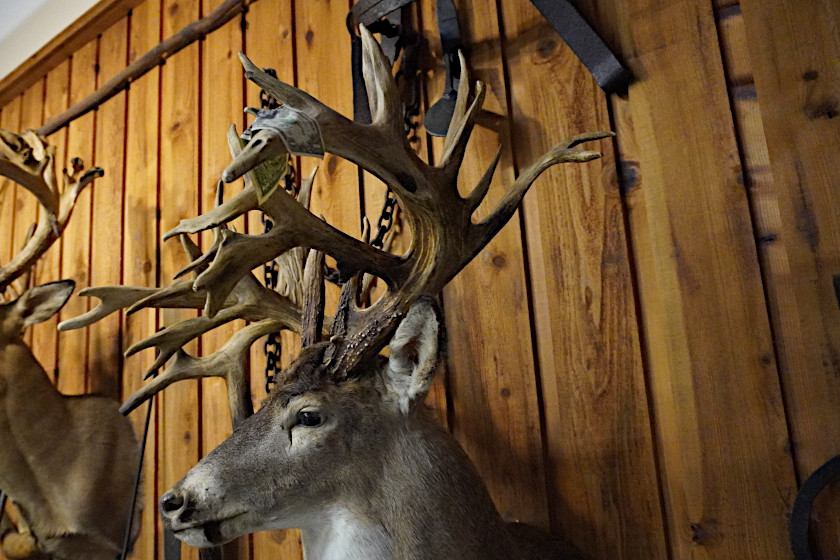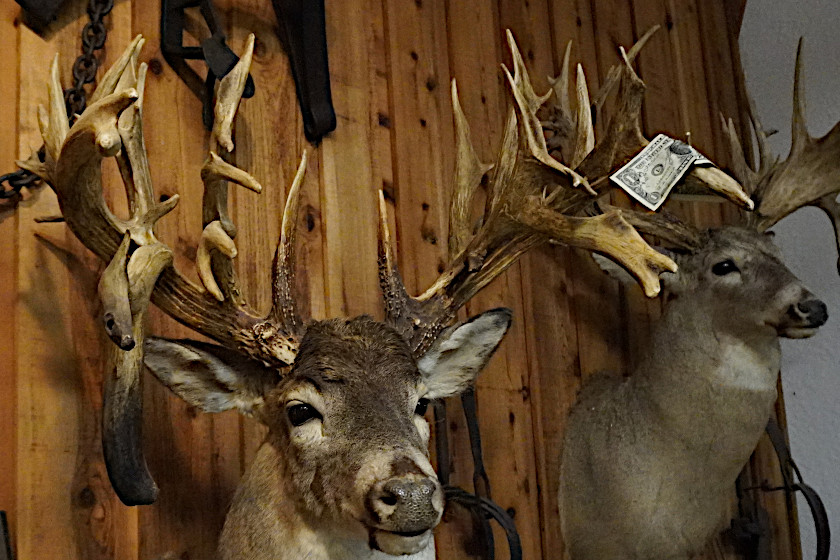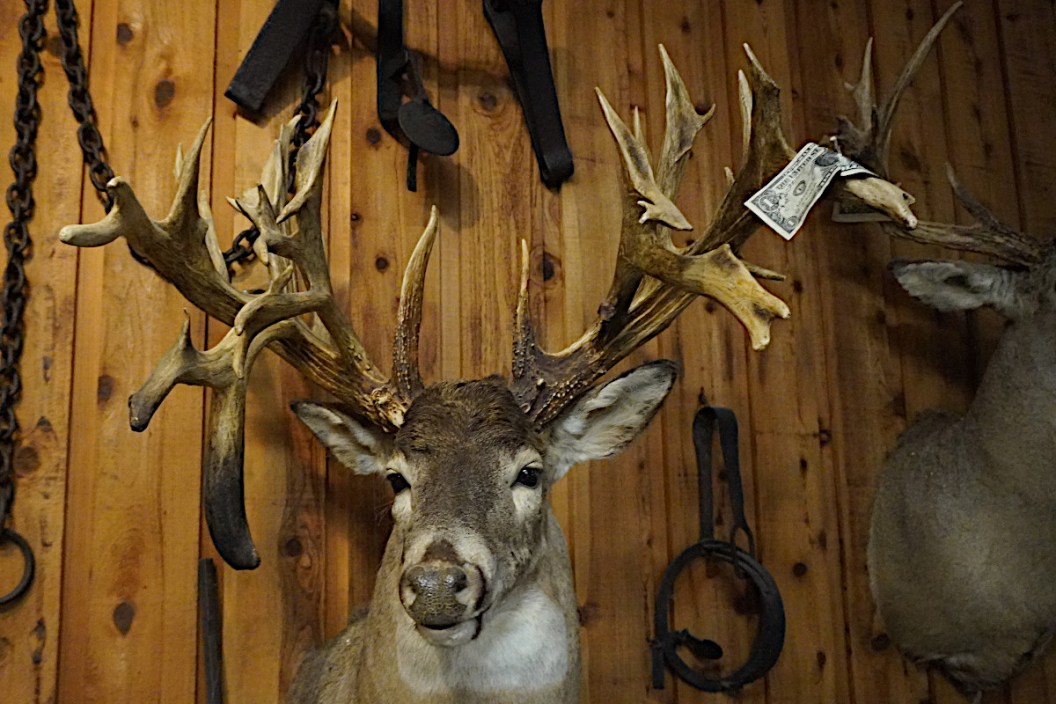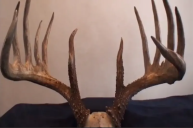Deer hunters have gotten a little cynical in the last 30 years. The worlds of high fences and genetic engineering have burned hunters enough times that many are now in total disbelief of what kind of antlers wild whitetail deer are capable of growing. However, there are a handful of confirmed whitetail bucks out there that have eclipsed the magical mark of 300+ inches non-typical completely in the wild.
Perhaps none is more mysterious than the Minnesota Monarch, a buck so massive and so cunning, no hunter ever caught up with it. The only reason we have an idea of how large this animal was is due to some shed antlers and a few photos of the deer.
Had he fallen to a hunter, there is a chance this whitetail deer could have been the largest of all time in the Boone and Crockett record books. This is the story of northern Minnesota's most legendary deer.
Where Did the Minnesota Monarch live?

Travis Smola
One of the more fascinating aspects of this non-typical whitetail's legend is the location. This deer didn't live in the vast agricultural areas of a state like Iowa, Ohio, or Indiana, states that have also produced 300-inch non-typical whitetails. Instead, the Monarch lived in St. Louis County, Minnesota, near the town of Ely. It's in the extreme northern end of the state and the potential world record buck allegedly spent most of its time living on public land in the Boundary Waters Canoe Wilderness area (BWCA). It goes against the popular belief in the deer hunting world that only states with access to great nutrients can grow deer of a world class caliber. Perhaps the lesson is we do not know these animals as well as we think we do?
Whatever the case may be, this non-typical buck was seen most often by one unidentified man in the late 1980s and early 1990s. Back then, feeding of deer was legal in Minnesota. The man kept a winter feeding area in his yard that drew lots of big deer. However, none came anywhere close to the caliber of the Monarch.
The strange thing about this deer was the man only saw the buck in February. Where it hid the rest of the year is a total mystery, although many have speculated it would be extremely easy for a monster buck to disappear into the wilderness backcountry of Boundary Waters. Especially in a time before trail cameras became a thing. According to the man who fed the deer, it was more reclusive than most whitetails. It would feed alone without interacting with other deer. It only took advantage of the feeding area during the worst of the winter before disappearing as quickly as it had appeared. Which makes sense, a buck this large and dominant likely ran himself ragged defending his turf every year during the rut. In 1990, he took a now-famous photograph of the deer when it was alive, standing on what appears to be a pile of hay or feed.
By all accounts, this buck was always impressive. However, it only grew a truly world class set of antlers in one season. This is where the story starts to get a little hazy on the details. Because according to North American Whitetail, three sets of sheds were recovered from the buck. The first was a 19-point set found in 1989, the second was a 39-point set found in 1990, and the third was a 30-point set found in 1991. There is some confusion with the exact number of sheds recovered, but we'll cover that in a moment.
We should note that it has been said the man who fed the deer experimented a bit with the supplements he was feeding the animals in January and February 1990. Perhaps giving the deer a few extra minerals he had not gotten in previous seasons. Some people have credited this bit of supplemental feeding as being a big reason the buck's rack blew up to such gigantic proportions later that season.
Just How Big was the Minnesota Monarch?

Travis Smola
According to Klaus Lebrecht's "Antlers by Klaus," the first set of antlers recovered from the Monarch were found in 1988 and score 209 6/8 without an inside spread credit. This would probably put the buck's antlers in the 230-inch range. A massive buck, but nowhere near world record size. This is where things get confusing. Because in 2008, the Minneapolis Star Tribune interviewed the man who recovered the antlers. During that interview, he insisted there was a second monster buck hanging around the area and that set of sheds came from that deer rather than the Monarch. In fact, the man said he only saw the Monarch in 1990 and 1991 before it disappeared. Make of that what you will.
Looking at the 1988 sheds, there is no denying there is a lot of the same characteristics between it and the Monarch's sheds. However, there is the possibility the deer had the same genetics and were possibly even siblings. Whatever the case may be, this isn't the set most hunters get excited about.
Because the 1990 set of sheds is the one that likely could have re-written the Boone & Crockett club record books. Because that season the buck's rack turned into a mess of stickers and drop tines. The right side could make B&C's record book on its own at 180 inches even, that is, if the club allowed sheds in the books. The left side scores 139 4/8 inches, which would be a big buck for most average bowhunters.
Put those two sides together, and you have a score of 319 4/8 inches non-typical. That's BEFORE adding in the inside spread, which can only be estimated. However, many experts have examined this deer over the years and have given it an estimated spread of 23 3/8 inches. With that, the Minnesota Monarch's potential score goes up to 334 inches.
For those of you up on your whitetail hunting history, you already know that means this buck could have beaten "The Missouri Monarch," a massive whitetail found dead outside St. Louis, Missouri in 1981. That deer's antlers score a sunning 333 7/8 inches. The Minnesota deer would also beat out the number two non-typical whitetail in B&C's record books, the "Hole-in-the-Horn" buck, which was found dead in Ohio in the 1940s and scores 328 2/8 inches. Had this buck fallen to a hunter, it seems it would have at least been somewhere in the top three whitetails of all-time. There is almost no question it would have been a new state record for Minnesota.
What Happened to the Minnesota Monarch?

Travis Smola
After it dropped its antlers in 1991, the Monarch was never seen again, by the man who became famous for feeding it, or anyone else for that matter. At least as far as we know. Theories on what happened to the deer vary. It seems most obvious the deer died sometime in the offseason from natural causes. If the buck was truly as old as everyone suspected, that would make it a 10.5-year-old in 1991. It was likely living on borrowed time already the three or four seasons prior, as whitetails over 6.5 years of age are somewhat rare. It's not a stretch to believe it simply died of old age. Another likely scenario is the buck met up with a wolf pack within the boundaries of the BWCA.
Several people have theorized the buck finally met its end at the hands of a hunter. Either the lucky hunter never reported the animal, or the fall 1991 rack was so drastically different, no one put two and two together on the animal's ID. That's exactly what Klaus Lebrecht, the man responsible for the many replicas of the buck's antlers, believes happened. Because a buck with a net score of 228 4/8 inches was taken not far away that fall.
"What convinces me is the markings of the deer," Lebrecht told the Star Tribune. "It was a very red deer. And he had a very distinct throat patch. The one she shot had that. I think it is the same deer."
It is unlikely we will never know for sure unless someone can produce some more concrete evidence the buck met his end with a hunter. To be fair, if it was us, we'd be shaking too hard in our tree stand to get a shot at a deer like this. However, perhaps there is a last set of antlers gathering dust in a garage or attic somewhere in Ely that has yet to be seen by the public? Either way, the buck's disappearance is the stuff of deer hunting legend and it's likely hunters in Ely are still talking about this animal every deer season, and likely will for many years to come.
For more outdoor content from Travis Smola, be sure to follow him on Twitter and Instagram For original videos, check out his Geocaching and Outdoors with Travis YouTube channels.
READ MORE: THE JOHNNY KING BUCK: A WISCONSIN WORLD RECORD WHITETAIL THAT WASN'T




